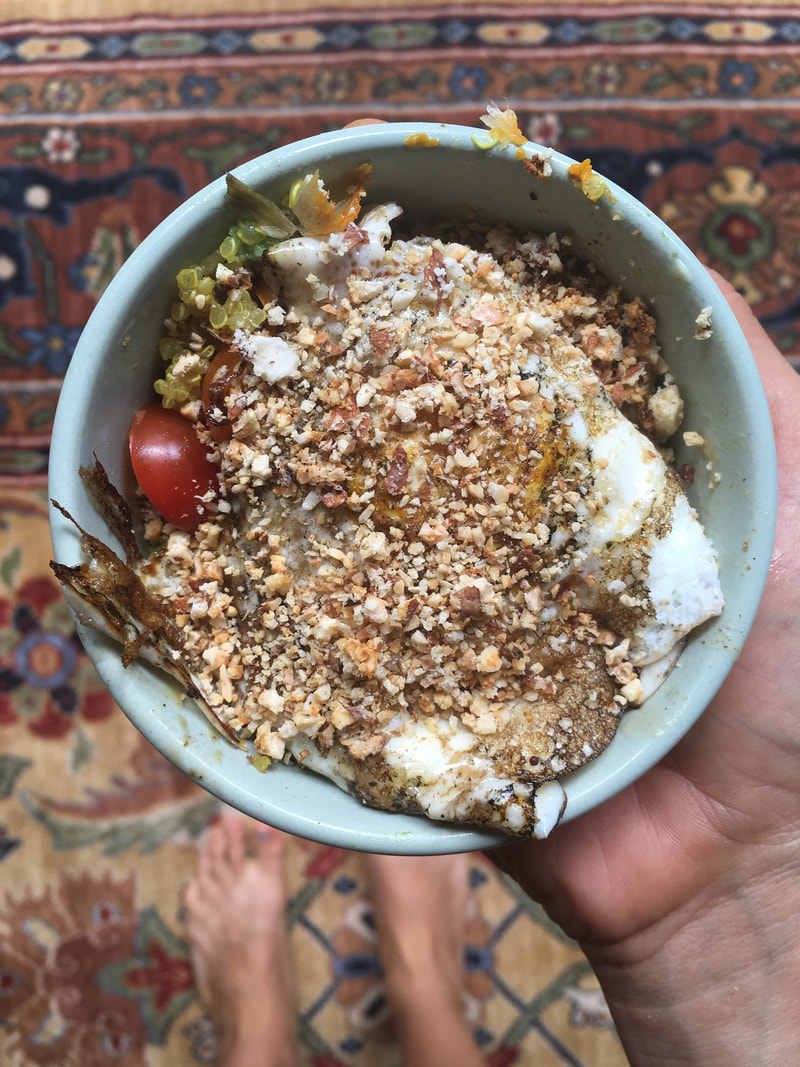|
Scientific Name: Ferula asafoetida (Latin ferula, “carrier”; asa, “resin”, and foetidus, “smelling fetid”) Common Names: Devil's dung, Stinking gum, Food of the gods, and Giant fennel, Hing Family: Apiaceae Taste/Energetics: Bitter, warm, grounding, stimulating Parts Used: gum resin from the rhizome and root of plant Actions: antispasmodic, carminative, digestive, expectorant, laxative, and sedative, antispasmodic, expectorant, stimulant, emmenagogue and vermifuge. About the plant: Native to Central Asia, eastern Iran, and Afghanistan. Ferula looks like a giant parsley plant. The tap root resembles a massive carrot. They are harvested when they are 4-5 years old in early spring before the plants flower. The roots are cut where stems protrude to allow it’s milky latex to pour out. The stinky, milky exudates are scraped off and collected, creating fresh wounds for more asafoetida gum resin harvesting. Fun fact: Asafoetida has been used historically as wolf bait Uses: Asafoetida is perhaps the most pungent and prevalent spice throughout Central Asia and the Middle East. Some say it’s what makes Indian food taste Indian. Asafoetida is what provides that onion-y, warming, mysterious flavor so characteristic of Indian and Persian food. Asafoetida has an extensive history of use as both a food and medicine. (As a low FODMAPPER with a tendency to be dry-skinned, cold-natured, and slow to digest, Asafoetida has become my best friend, but more on this later). For one, Asafoetida has an incredible taste. I would say it is a combination of miso, onion, garlic, and saffron with a touch of egg. It’s such a complex and intense flavor that a little bit goes a really long way. Asafoetida accentuates other herbs which is why it is traditionally mixed into blends like Kitchari (a popular blend for stewing veggies and flavoring rice and lentils; I adore it on scrambled or fried eggs) and Hingvastak churna, a digestive blend used in Ayurveda for those with a cold digestion by nature. Asafoetida has a history of being used for nervous, digestive, and respiratory system conditions and afflictions. Asafoetida was once used to treat hysteria, although these days we refer to that as a good ole’ sedative. Going along with it’s calming nature, it also can thin the blood and lowers blood pressure. As a respiratory system aid, it’s used for ameliorating spasmodic, inflamed conditions like bronchitis, asthma and whooping cough. Additionally, the volatile oil in the gum is eliminated through the lungs, making this an excellent treatment for asthma. It’s indicated for those with “spasmodic tightness” in their lungs, given the feeling of incomplete breath/air hunger. In Ayurveda, the Traditional Medicine of India, it is said to nourish and relieve stagnation of the nervous tissue for cases of sciatica, paralysis, and epilepsy (cold conditions). As a digestive aid, it has a few mechanisms of action. For one, it is invigorating to any stagnant gut condition, stimulating blood flow, digestive juice secretion, and peristalsis to get things moving and grooving. It’s high volatile oil content acts as a carminative, popping gas bubbles left and right and relieving lower abdomen distention. Therefore, it’s great for gas! In Ayurveda, it is one of the primary herbs indicated for people with a cold and dry constitution (vata). People with a vata constitution have a hard time regulating heat in their body. Their digestion is often slow, yielding gas, belly distention, and constipation. On that same note, Asafoetida can clear coldness and stagnation in the uterus, regulating periods and easing spastic cramps. It is said to warm the uterus and stimulate menstruation. And it’s great for low libido (often the case of low blood flow, invigoration in the nether regions). Hing is also known to reduce Candida growth and other pesky, unwanted gut flora, viruses, and worms. (they are probably turned off by how stinky it is!). In fact, Asafoetida was used to combat the flu during WWI because of its antiviral properties Contraindications: Do not use in medicinal/high dosage quantities. In large amounts, an abortifacient quality has been noted due to it's stimulating qualities. Simple, Savory Kitchari Egg Recipe
In a cast iron skillet, melt 2 tbsp grass fed butter or ghee on medium-high heat. Add 1 tsp of kitchari spice and ¼ tsp paprika. Let infuse into the butter for a few minutes until the kitchen is smelling fragrant and lovely. When you can hear it sizzling, crack an egg into the buttery spices. Top with a bit of sea salt, black pepper, and freshly shaved pecorino or parmesan cheese. Let cook on medium-high for 1 minute. Flip over and douse with a few shakes of Coconut aminos. Cap the pan with a lid and turn the burner off but leave the pan on the burner. Meanwhile. Slice up half an avocado and whip up some dijonaisse using the ratio of 1:3 - dijon:mayo (just make sure it’s coconut oil or avocado oil mayo- we don’t want any rancid vegetable oils inflaming our breakfast!) At this point (about 4-5 minutes later), the kitchari egg should be totally cooked. Remove it from the pan and slide it onto the sliced avocado. Top with a dollop of dijonnaise. Fresh chopped parsley and crispy almond crumbs, toasted coconut, and/or bacon bits adds a nice finishing touch!
Emery
9/18/2019 12:03:43 am
Would this be safe for breastfeeding?
Hey Emery,
Sasha Gracia
11/2/2019 09:12:40 am
Comments are closed.
|
Eileen Brantley & Amy WrightWe are Herb Girls Athens, LLC. Read our blog! Archives
November 2022
Categories
All
|




 RSS Feed
RSS Feed
